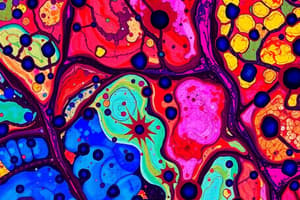Podcast
Questions and Answers
What is the main purpose of staining in histology?
What is the main purpose of staining in histology?
- To remove paraffin from the slide
- To identify the type of disease present
- To preserve the tissue sample
- To differentiate tissue components by imparting a characteristic color (correct)
What is the type of staining used in microbiology?
What is the type of staining used in microbiology?
- Romanowsky Staining
- Gram's Stain & Ziel-Neelsen Staining (correct)
- H&E Staining
- Papanicolaou Staining
What is the mechanism by which basic dyes stain nuclei?
What is the mechanism by which basic dyes stain nuclei?
- Hydrophobic interactions between the dye and nucleus
- Electrostatic attraction between oppositely charged particles (correct)
- Covalent bonding between the dye and nucleus
- Formation of dye-salt unions
What is the characteristic of cytoplasmic proteins below pH 6?
What is the characteristic of cytoplasmic proteins below pH 6?
What is the function of chromophores in dyes?
What is the function of chromophores in dyes?
What is the purpose of dewaxing in the staining process?
What is the purpose of dewaxing in the staining process?
What is the type of staining used in cytology?
What is the type of staining used in cytology?
What is the term for the attraction between oppositely charged particles in staining?
What is the term for the attraction between oppositely charged particles in staining?
What is the characteristic of nuclei that allows them to bind to basic dyes?
What is the characteristic of nuclei that allows them to bind to basic dyes?
What is the purpose of staining in histopathology?
What is the purpose of staining in histopathology?
Flashcards are hidden until you start studying
Study Notes
Staining
- Staining is a process that renders different tissue components more visible through variation in color, promoting easier optical differentiation and identification of cell and tissue components.
- It involves treating tissue or cells with a series of reagents to acquire a color, making it transparent and facilitating visualization under the microscope.
Purpose of Staining
- Outlines tissue and cellular components
- Enables identification of tissues
- Establishes the presence or absence of disease processes in histology and histopathology
Common Staining Methods
- H&E Staining (Histopathology)
- Gram's Stain & Ziel-Neelsen Staining (Microbiology)
- Romanowsky Staining (Hematology)
- Giemsa Staining (Parasitology)
- Papanicolaou Staining (Cytology)
General Procedure
- Begins with complete removal of paraffin in fixed sections of slides through dewaxing
- Dewaxing involves heating the slides in 60°C for at least 30 minutes to soften the wax, followed by immersion in xylene and descending concentrations of alcohol to distilled water prior to primary stain
Staining Mechanism
- Principles of histological technique for distinction of tissue components are based on:
- Alteration of contrast
- Alteration of color
- Alteration of contrast between the parts of the tissue
Nuclear Staining
- Nuclei are acidic, anionic, or negatively charged
- Stain with basic dye (blue) under the microscope, which is cationic or positively charged
- Reaction results in a basophilic reaction, forming dye-salt unions, producing a bluish to purple color
Cytoplasmic Staining
- Cytoplasm is amphoteric due to terminal amino and carboxyl groups
- May appear basophilic or acidophilic, depending on the substance present in the cytoplasm
- Net charge of cytoplasmic proteins:
- Below pH 6: positive (+) with high affinity to negative (-) charged dye, resulting in reddish to orange color
- Above pH 6: negative (-) with high affinity to positive charged (+) or cationic dyes, resulting in purplish to bluish color
Dyes/Stains
- Chemical or reagents with aromatic benzene ring compounds (or derivatives) that possess the twin properties of:
- Color band
- Ability to bind tissues
- All dyes are organic compounds, mostly derivatives of coal tar or benzene
- Now, there are synthetic dyes
Integral Components of Dyes
- Chromophores
- The group on the benzene ring that confers color (C=C, C=O, C=S, N=N, N=O, and NO2)
- Alters the light resonance properties of the compound, resulting in unequal absorption when white light is passed through
Studying That Suits You
Use AI to generate personalized quizzes and flashcards to suit your learning preferences.




